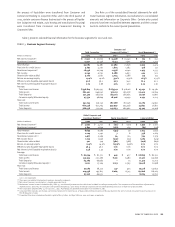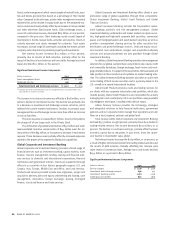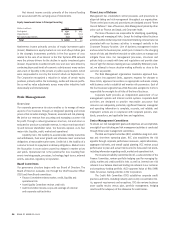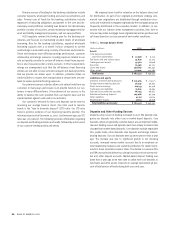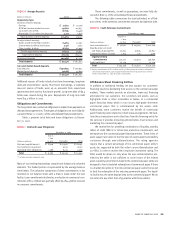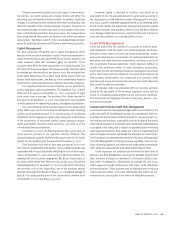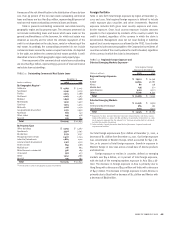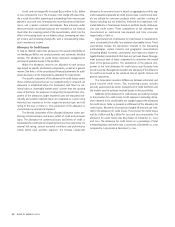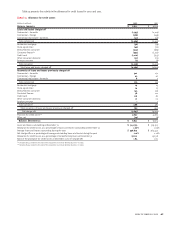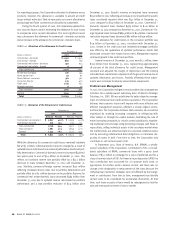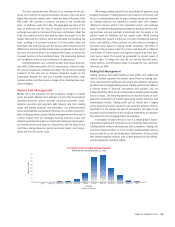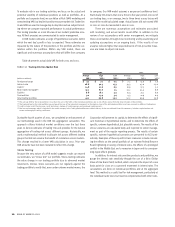Bank of America 2002 Annual Report Download - page 42
Download and view the complete annual report
Please find page 42 of the 2002 Bank of America annual report below. You can navigate through the pages in the report by either clicking on the pages listed below, or by using the keyword search tool below to find specific information within the annual report.
40 BANK OF AMERICA 2002
We manage our credit risk on these commitments by subjecting
them to our normal underwriting and risk management processes. At
December 31, 2002 and 2001, the Corporation had off-balance sheet
liquidity commitments and SBLCs to these financing entities of
$34.2 billion and $36.1 billion, respectively. Substantially all of these
liquidity commitments and SBLCs mature within one year. These
amounts are included in Table 8. Net revenues earned from fees
associated with these financing entities were approximately $484 mil-
lion and $256 million for 2002 and 2001, respectively.
We generally do not purchase any commercial paper issued by
these financing entities other than during the underwriting process
when we act as issuing agent nor do we purchase any of the commer-
cial paper for our own account. We do not consolidate these types of
entities based on the accounting guidance contained in ARB No. 51,
“Consolidated Financial Statements”, SFAS No. 94, “Consolidation of
All Majority-Owned Subsidiaries”, EITF Issue No. D-14, “Transactions
Involving Special Purpose Entities”, and EITF Issue No. 90-15,
“Impact of Nonsubstantive Lessors, Residual Value Guarantees, and
Other Provisions in Leasing Transactions”. Derivative instruments
related to these entities are marked to market through the statement
of income. SBLCs and liquidity commitments are accounted for pur-
suant to SFAS No. 5, “Accounting for Contingencies”(SFAS 5), and are
discussed further in Note 13 to the consolidated financial statements.
In January 2003, the FASB issued a new rule that addresses off-
balance sheet financing entities. As a result, we expect that we will
have to consolidate our multi-seller asset backed conduits beginning in
the third quarter of 2003, as required by the rule. As of December 31,
2002, the assets of these entities were approximately $25.0 billion. The
actual amount that will be consolidated is dependent on actions taken
by the Corporation and our customers between December 31, 2002
and the third quarter of 2003. Management is assessing alternatives
with regards to these entities including restructuring the entities
and/or alternative sources of cost-efficient funding for our customers
and expects that the amount of assets consolidated will be less than
the $25.0 billion due to these actions and those of our customers.
Revenues from administration, liquidity, letters of credit and other
services provided to these entities were approximately $121 million in
2002 and $125 million in 2001. The new rule requires that for entities
to be consolidated that those assets be initially recorded at their car-
rying amounts at the date the requirements of the new rule first apply.
If determining carrying amounts as required is impractical, then the
assets are to be measured at fair value the first date the new rule
applies. Any difference between the net amount added to the
Corporation’s balance sheet and the amount of any previously recog-
nized interest in the newly consolidated entity shall be recognized as the
cumulative effect of an accounting change. Had we adopted the rule in
2002, there would have been no material impact to net income. See
Note 1 of the consolidated financial statements for a discussion regard-
ing management’s estimated impact of the new rule in 2003.
In addition, to control our capital position, diversify funding
sources and provide customers with commercial paper investments,
from time to time we will sell assets to off-balance sheet commercial
paper entities. The commercial paper entities are special purpose
entities that have been isolated beyond our reach or that of our
creditors, even in the event of bankruptcy or other receivership.
Assets sold to the entities consist primarily of high-grade corporate or
municipal bonds, collateralized debt obligations and asset-backed
securities. These entities issue collateralized commercial paper to
third party market participants and passive derivative instruments to
us. Assets sold to the entities typically have an investment rating rang-
ing from Aaa/AAA to Aa/AA. We may provide liquidity, SBLCs or similar
loss protection commitments to the entity, or we may enter into a
derivative with the entity in which we assume certain risks. The liq-
uidity facility and derivative have the same legal standing with the
commercial paper.
The derivative provides interest rate, currency and a pre-spec-
ified amount of credit protection to the entity in exchange for the
commercial paper rate. This derivative is provided for in the legal
documents and helps to alleviate any cash flow mismatches. In some
cases, if an asset’s rating declines below a certain investment quality
as evidenced by its investment rating or defaults, we are no longer
exposed to the risk of loss. At that time, the commercial paper holders
assume the risk of loss. In other cases, we agree to assume all of the
credit exposure related to the referenced asset. Legal documents for
each entity specify asset quality levels that require the entity to auto-
matically dispose of the asset once the asset falls below the speci-
fied quality rating. At the time the asset is disposed, we are required
to reimburse the entity for any credit-related losses depending on the
pre-specified level of protection provided.
We also receive fees for the services we provide to the entities,
and we manage any credit or market risk on commitments or deriva-
tives through normal underwriting and risk management processes.
Derivative activity related to these entities is included in Note 5 of the
consolidated financial statements. At December 31, 2002 and 2001, the
Corporation had off-balance sheet liquidity commitments, SBLCs and
other financial guarantees to the financing entities of $4.5 billion and
$4.3 billion, respectively. Substantially all of these liquidity commit-
ments, SBLCs and other financial guarantees mature within one year.
These amounts are included in Table 8. Net revenues earned from fees
associated with these entities were $37 million and $49 million in
2002 and 2001, respectively.
We generally do not purchase any of the commercial paper
issued by these types of financing entities other than during the
underwriting process when we act as issuing agent nor do we pur-
chase any of the commercial paper for our own account. We do not
consolidate these types of entities because they are considered
Qualified Special Purpose Entities as defined in SFAS No. 140,
“Accounting for Transfers and Servicing of Financial Assets and
Extinguishments of Liabilities”. Derivative instruments related to
these entities are marked to market through the statement of
income. SBLCs and liquidity commitments are accounted for pur-
suant to SFAS 5 and are discussed further in Note 13 to the con-
solidated financial statements.



